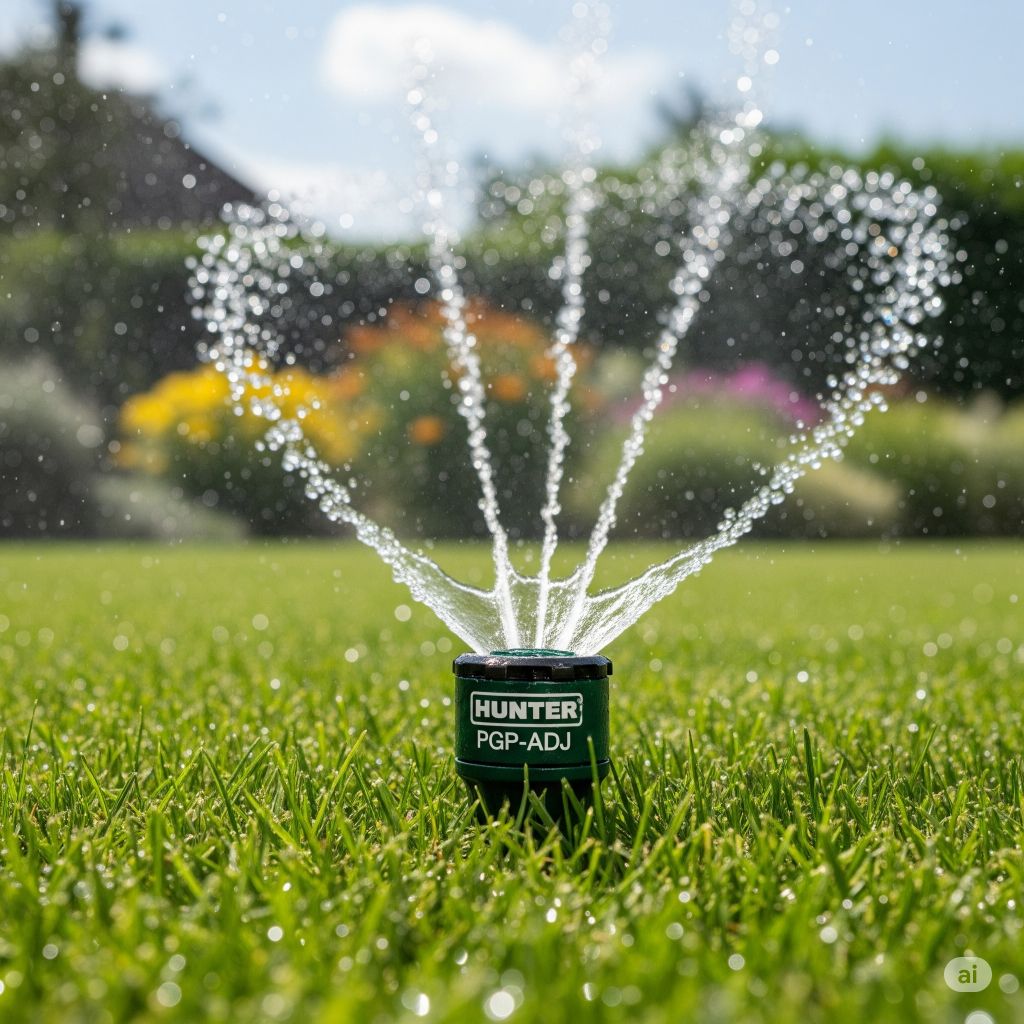
Hunter Industries is a trusted name in irrigation systems, and their sprinkler heads—known for durability, performance, and adjustability—are used in residential and commercial landscapes worldwide. But to get the best performance, adjusting your Hunter sprinkler heads correctly is crucial.
This in-depth guide covers:
- Types of Hunter sprinkler heads
- How to adjust spray and rotor models
- Arc and radius control
- Maintenance tips
- Troubleshooting common issues
- Product selection tips and specifications
🔧 Understanding Hunter Sprinkler Head Types
Hunter offers a variety of sprinkler heads, but the most common fall into two broad categories:
1. Rotor Sprinklers (e.g., PGP, I-20, I-25, Pro Rotor)
- Designed for larger areas
- Rotating spray with adjustable arc and radius
- Pop-up heights: 4″, 6″, 12″
- Spray distance: 17–50 ft
2. Spray Sprinklers (e.g., Pro-Spray, PS Ultra)
- Fixed spray pattern
- Ideal for smaller areas and flower beds
- Can be paired with adjustable nozzles
- Spray distance: 5–15 ft
⚠️ Always identify the model before adjusting—it influences the adjustment method.
🛠️ Tools You Need for Adjustment
- Hunter rotor adjustment tool (comes with PGP models)
- Flathead screwdriver (for spray heads)
- Needle-nose pliers (for nozzle replacement)
- Gloves (optional for muddy installations)
🔄 How to Adjust Hunter Rotor Sprinkler Heads (e.g., PGP Ultra, I-20)
Step 1: Adjusting the Arc (Spray Angle)
Arc refers to the part of the circle the sprinkler covers.
Default Range: 40° to 360°
To Increase Arc:
- Insert the plastic key of the adjustment tool into the arc adjustment slot (marked +).
- Turn clockwise to increase.
- Each full 360° turn = ~90° increase.
To Decrease Arc:
- Turn counter-clockwise in the same slot.
- Stop once it reaches the minimum (40°) or you hear resistance.
Step 2: Adjusting the Radius (Spray Distance)
- Insert the steel hex end of the tool into the radius screw (center of nozzle).
- Turn clockwise to reduce spray distance.
- Turn counter-clockwise to increase (up to 25–50 ft depending on model).
💡 Do not overtighten or remove the radius screw—it holds the nozzle in place.
Step 3: Changing the Nozzle (Optional)
- Pull up the riser using the Hunter tool.
- Use pliers to remove old nozzle.
- Insert new nozzle firmly and re-tighten radius screw to secure.
🔁 How to Adjust Hunter Spray Heads (e.g., Pro-Spray)
Step 1: Choose the Right Nozzle
Hunter spray heads use interchangeable nozzles:
- Fixed pattern: 90°, 180°, 360°
- Adjustable pattern: 0° to 360°
- MP Rotator: Multi-stream, rotating sprays with higher efficiency
Step 2: Adjusting the Spray Pattern
For adjustable nozzles:
- Use a small flathead screwdriver on the top screw.
- Turn clockwise to reduce the arc.
- Turn counter-clockwise to widen.
Tip: Rotate the nozzle manually to aim it at the desired starting angle.
Step 3: Adjusting Spray Distance
- Turn the center screw:
- Clockwise: Reduces water distance
- Counter-clockwise: Increases it
Spray heads typically cover 5–15 feet depending on nozzle type and water pressure.
🧪 Testing and Fine-Tuning
After making adjustments:
- Turn on the irrigation zone.
- Observe coverage.
- Adjust arc/radius as needed for overlap (known as head-to-head coverage).
- Make sure there’s no overspray onto sidewalks, driveways, or structures.
⚙️ Common Hunter Sprinkler Adjustments Quick Table
| Adjustment | Rotor Models (PGP, I-20) | Spray Models (Pro-Spray) |
|---|---|---|
| Arc | Key in arc slot, turn +/– | Rotate nozzle manually or screw top |
| Radius | Turn center screw | Turn center screw |
| Direction | Rotate turret by hand | Rotate nozzle |
| Nozzle | Pull riser, swap nozzle | Unscrew top, insert new nozzle |
🧹 Maintenance Tips
1. Cleaning Nozzles
- Remove and rinse under water
- Use a paperclip to clean clogs
- Check for debris or bugs inside the nozzle
2. Check for Leaks
- Look for puddling or constant leaking
- Replace damaged riser seals or valves
3. Seasonal Shutdown
- Winterize by blowing out lines with compressed air
- Recheck alignment and operation in spring
4. Adjust for Growth
- Plants or grass may block spray
- Trim obstructing vegetation or raise sprinkler height
🧩 Troubleshooting Common Hunter Sprinkler Head Issues
| Problem | Likely Cause | Fix |
|---|---|---|
| Sprinkler not popping up | Low pressure, debris, or bad seal | Clean filter; check pressure/seal |
| Uneven spray pattern | Clogged nozzle | Remove and clean nozzle |
| Overspraying sidewalk/driveway | Arc too wide | Reduce arc with adjustment tool |
| Leaks around sprinkler base | Cracked housing or seal | Replace body or riser seal |
| Poor pressure in one zone | Valve issue or mainline clog | Check valve box and filters |
📐 Hunter Sprinkler Head Specs (Popular Models)
🔹 PGP Ultra Rotor
- Spray Distance: 22–52 ft
- Arc: 40°–360°
- Pressure: 30–70 PSI
- Nozzles: 12 standard + 8 low-angle
🔹 I-20 Rotor
- Spray Distance: 17–46 ft
- Arc: 40°–360°
- Optional stainless riser
- Great for medium commercial zones
🔹 Pro-Spray Fixed Spray
- Spray Distance: 5–15 ft (based on nozzle)
- Pressure: 20–75 PSI
- Available in 2″, 4″, 6″, 12″ pop-ups
✅ How to Choose the Right Hunter Sprinkler Head
| Area Type | Best Model Type |
|---|---|
| Small Lawn | Pro-Spray + MP Rotator |
| Medium Lawn | PGP Ultra |
| Large Lawn | I-25 or I-40 |
| Flower Beds | Fixed Spray or Bubblers |
| Slopes or Windy | MP Rotator (low precipitation rate) |
Use head-to-head spacing and avoid mixing rotors with sprays in the same zone.
💡 Pro Tips for Better Watering
- Water early morning (4–6 am) to minimize evaporation
- Use pressure regulation to ensure uniform spray
- Avoid runoff by splitting long watering sessions into cycles
- Upgrade to MP Rotators for improved efficiency (up to 30% water savings)
🌎 Eco-Friendly Irrigation Upgrades
- Add rain sensors or weather-based controllers
- Switch to low precipitation rate heads
- Use drip irrigation for shrubs and borders
Final Thoughts
Hunter sprinkler heads are among the most reliable on the market—but only when adjusted and maintained correctly. Understanding how to tweak arc, radius, and nozzle configuration ensures your landscape receives even, efficient watering without waste.
With just a simple tool and a few minutes per head, you can save water, reduce utility bills, and keep your garden thriving.
Would you like this guide as a downloadable PDF, or split into web sections with images and SEO headings for WordPress or blog publishing?

I’m David man behind Lawn Mowerly; I’ve been dealing with lawnmowers and Tractors with my father since I was a kid. I know every make and model and what each one is capable of and love helping people find the perfect equipment for their needs.
